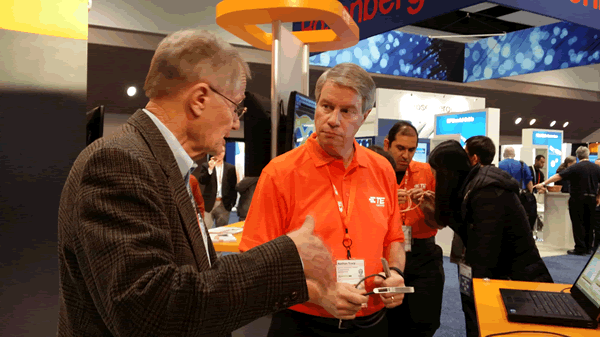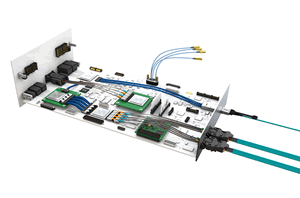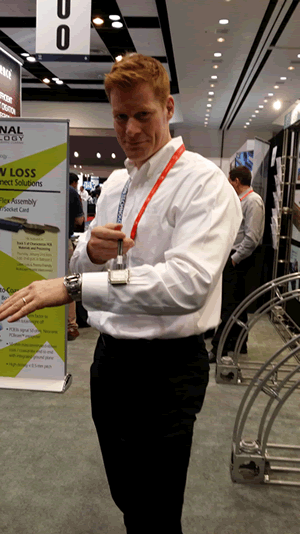Interconnect News from DesignCon
If you weren’t lucky enough to attend DesignCon, here’s your guide to the major product announcements made at the show.
DesignCon 2016 is in the books, and the show did not disappoint when it came to showcasing the latest technology.
TE Connectivity
TE Connectivity showed a range of industry-leading data communications connectivity solutions, with working demonstrations and displays of the latest products that deliver the speed, scalability, space savings, reduced thermals, power, and reach that design engineers need.

Bishop & Associates’ Bob Hult and TE’s Nathan Tracy discuss the importance of microQSFP technology.
TE’s exhibit included the advanced family of STRADA Whisper high-speed backplane connectors with an expanded range of configurations including direct-plug orthogonal, mezzanine, and cables all delivering at least 56Gb/s; the new Sliver internal interconnect cabled connectors that enable extended reach at 25Gb/s for on-board or embedded applications; and the new micro quad small-form-factor pluggable (microQSFP) high-speed I/O solutions, with demonstrations on thermal performance, RU faceplate density, and data throughput capabilities.
microQSFP
TE will be the first to develop microQSFP connectors and cages in accordance with the new specification released by the microQSFP Multi-Source Agreement (MSA) group on January 15, 2016. The specification was addressed at many booths on the show floor.
The module and cage draft mechanical details allow system designers, optical module makers, and copper cable assembly providers across the industry to begin the process of developing next-generation hardware based on the microQSFP definition. The founding promoter members of the MSA include Broadcom, Brocade, Cisco, Dell, Foxconn Interconnect Technology, Huawei, Intel, Juniper Networks, Lumentum, Microsoft, Molex, and TE Connectivity; the MSA group is currently soliciting new contributory members to help expand the adoption of microQSFP in the marketplace. This reflects the growing stability of the specification.
The microQSFP transceiver module is a compact hot-pluggable style input/output (I/O) connector system with four electrical channels that support both direct-attach copper cable assemblies and optical modules. The unique features include a higher-contact-density electrical interconnect that provides 33% higher density than the existing QSFP connector system and integrated thermal management that significantly improves the thermal performance over QSFP connectors and cages.
With the same width as the existing single-channel SFP form factor, microQSFP ports offer the industry a familiar module width, but with up to four times the data capacity. The microQSFP form factor may be used with one, two, or four channels, and the enhanced thermal features offer a way to support more thermally challenging applications.
Connector signal integrity performance will support existing industry specifications for up to 28Gb/s per channel, and it is intended to support 50Gb/s PAM-4 requirements as well. Future generations of microQSFP connectors should address higher data rates. When operating at 25Gb/s per channel, the solution enables up to 7.2 Tb/s per 1RU line card with 72 ports.
“Networking hardware trends are moving to ever-higher density interconnects and higher data rates,” says Dale Murray, principal analyst with LightCounting Market Research. “Coupled with higher-capacity switching silicon, this results in a need for next-generation connector systems such as microQSFP that provide more throughput while also addressing the thermal challenge in new ways.”
Molex
With a focus on next-gen interconnect solutions and a new path to development, Molex, also a founding member of the microQSFP MSA group, debuted advanced heat-dissipation options, analysis tools, backplane solutions, and other products:
- High-Speed Low-Loss Flex Circuit Assemblies, fabricated using DuPont Pyralux TK flexible circuit material, are designed for electronic data transmission applications, such as servers and high-end computing, storage servers, and signal processing.
- The NeoPress High-Speed Mezzanine System offers system architects design flexibility through a unique triad structure, enabling the universal housing to populate 85-ohm, 100-ohm, and power triads in any housing slot. The reliable, high-speed design supports systems with 28Gb/s high-speed signal transmissions.
- New Impel Plus Backplane Connectors provide data rates up to 56Gb/s and include a grounding tail aligner, which allows for smaller signal-compliant pins and optimizes signal integrity performance. An innovative signal beam design improves insertion loss compared to in-line beams and pushes interface resonance frequency past 30GHz.
Additionally, Molex and Credo Semiconductor demonstrated both 50Gb/s NRZ and 50Gb/s PAM-4 live serial traffic using a high-speed copper cable on the zQSFP form factor. Credo supplied transmitting and receiving electronics to drive a cable assembly using 50Gb/s NRZ and 50Gb/s PAM-4 encoded data streams. The demo used a Molex zQSFP+ cable assembly and a zQSFP+ SMT connector interface.
Other demonstrations at the Molex booth included the Impel backplane technology operating in compliance to OIF CEI-56G-LR on various channel lengths using Megtron 6 material and Avago Technologies’ PAM-4 test silicon; the latest stacked zQSFP+ connector thermal management technologies featuring the zQSFP+ Thru-Flow and Internal Riding Heat Sink (IRHS); and the NeoPress High Speed Mezzanine solution at 28Gb/s in a live demonstration that showcased NeoPress channel performance and the ease of operating Tektronix’s equipment and software.
“We find that DesignCon provides the right forum to showcase our complete product portfolio and introduce new technologies to our customers in a relaxed, informal environment,” says Jairo Guerrero, director of marketing, enterprise business unit, Molex. “It is all about the customer experience, and interactive demos allow us to demonstrate key performance features alongside our silicon partners in real channel applications, making it a more hands-on experience.”
Busy Booths on the Floor

FCI’s Evelyn Wee explained the finer points of high-speed connectors to Chiphead.
FCI’s comprehensive display featured the company’s “Basics” product line; quicker, faster, better storage connectors; innovative high-speed backplane solutions; and a wide range of power solutions including HSIO high-speed copper and optical cable assemblies.
Amphenol showcased a number of new products including an RCx-optimized copper intra-rack I/O system, derivatives of the Paladin Interconnect System including Ortho Mate and Cable Backplane, the Cool Edge Interconnect System, 100G AOCs, and ultraspeed high-performance PCB technology.

Samtec’s “flyover” technology was the cornerstone of its DesignCon exhibit.
Samtec, Inc. featured a silicon-to-silicon product demonstration that included built-in pattern generation for bit rate, BER and eye pattern monitoring of each channel featuring the FQSFP Series Flyover QSFP System, the Z-Ray One Piece Interposer, the ExaMAX High-Speed Backplane, and SEARAY Open Pin Field Array interconnects. Other demonstrations included Channelyzer, an online full-channel simulation/analysis tool, and the augmented reality app to examine ExaMAX as a real-time 3D image.
When asked to describe DesignCon 2016 from the company’s perspective, Brian Vicich, CTO, Samtec, only needed one word: “Flyover.” The new FQSFP Series is a flyover QSFP assembly that improves signal integrity by flying critical data over lossy PCB materials, thus providing more flexibility in the system architecture. The FQSFP achieves 28Gb/s performance and is backward-compatible with all QSFP cable assemblies.
“DesignCon 2016 was packed and productive this year for Samtec,” says Matt Burns, technical marketing manager, Samtec. “DesignCon attendees across many industries were interested to learn more about silicon-to-silicon system optimization capabilities such as IC designers who wanted to learn more about ruggedized IC packaging and assembly capabilities and test and measurement companies requesting more information on high-speed copper and optical cable assemblies.”

Omnetics’ Bob Stanton explains small space satellites to our editor with the aid of a french fry basket, water glass, and salt and pepper shakers.
AirBorn Inc. announced significant enhancements to its HD4 interconnect solution. Improvements include “inverted T” termination on the board-mount connector, solid conductor and stranded wire options, enhanced backshell casing, and UL, CSA, and RoHS certifications.
Yamaichi Electronics introduced the CFP8 connector, a new pluggable optical-module form factor established by CFP-MSA for 400Gb Ethernet. The connector is capable of up to 16 channels of 28G baud electrical signal for CDAUI-16 and CDAUI-8 and also 56G baud electrical signal for future demand.
HUBER+SUHNER unveiled the new Sucotest 500V Series vector network analyzer (VNA) test leads, which feature a ruggedized cable and network measurement division (NMD) connectors capable of withstanding repetitive mating, flexure, crushing, twisting, and bending. These qualities allow it to deliver market-leading temperature and movement stability, helping users achieve extremely accurate measurements, improved system reliability, longer service lifetimes, and reduced equipment downtime in RF testing environments. Also launched at the show, the 80GHz coaxial-to-PCB all-in-one solution exhibits broadband characteristics from DC to 80GHz, features easy-attach MMPX snap connectors, delivers excellent electrical performance, and enables high-end measurement setups for both high-speed digital and RF testing.
Carlisle Interconnect Technologies launched a lineup of products designed to deliver high signal integrity in increasingly dense applications. New products include the CoreGD and CoreHC RF adapters; Secure-Thread, one of the smallest threaded lock connectors available; and the Passive Probe, a 500Mhz CAT III/IV general-purpose, high-voltage probing solution.

Meritec’s Russ Herbert shows off the new Hercules High-Speed interface, now embedded in the D-sub rugged-rectangular MIL-DTL-24308 shell.
Meritec featured its new Hercules High-Speed interface, used in VITA 76.0, now embedded in the new (HS-D) D-Sub rugged-rectangular MIL-DTL-24308 shell, which provides high bandwidth, high pin count, and durability suitable for mil/aero and rugged commercial applications not previously accommodated by industry-standard connectors.
Neoconix introduced its FPConnected family, which integrates its novel connector products into high-performance FPC assemblies. The U31C Series simplifies USB Type-C implementation and terminates on-board with a low-profile X-Beam connection. The XFPC Series incorporates X-Beam terminations at each end of a customer-chosen FPC length.
Micro-Coax launched three new microminiature coaxial cables and the connector-design capability to support them. The new cables are the TGZ025D, a true flexible cable with an outer diameter of 0.65mm; UT-020-TP, a tin-plated version of its popular semi-rigid cable; and UT-042, the newest member of its semi-rigid lineup.
Ironwood Electronics announced 75GHz-bandwidth test sockets for engineering applications. GT is a new elastomer technology that has silver particles held in a conductive column, similar to buttons, which are embedded in a non-conductive polyimide substrate on a proper pitch that provides high compliance and extreme temperature ranges.
Lorom America demonstrated the future of copper with channel speeds in excess of 320Gb/s in the existing QSFP+ form factor. Additionally, its new 28G SFP+/QSFP+ Passive Cables feature a proprietary low-loss cable technology, lowering cooling costs and reducing power consumption compared to fiber.
“From a technology standpoint, 56 Gb/s data rates were the hot topic at this show,” says Samtec’s Matt Burns. “The technology tracks offered attendees practical guidance on 56Gb/s PCB layout, test techniques, and other engineering topics while the trade show demonstrated the new products that will gain traction in 2016 and beyond.”
In Friday’s issue, Bob Hult will take a closer look at the technology trends and advances and what they mean for design engineers.




